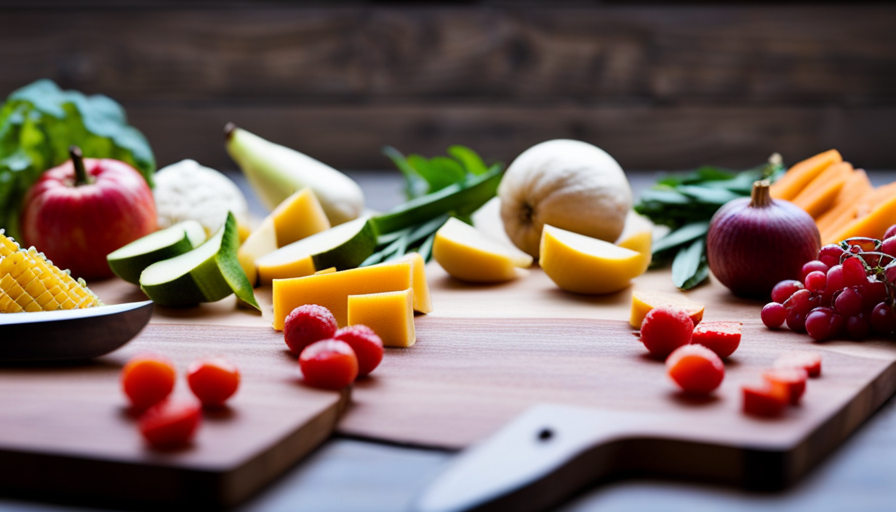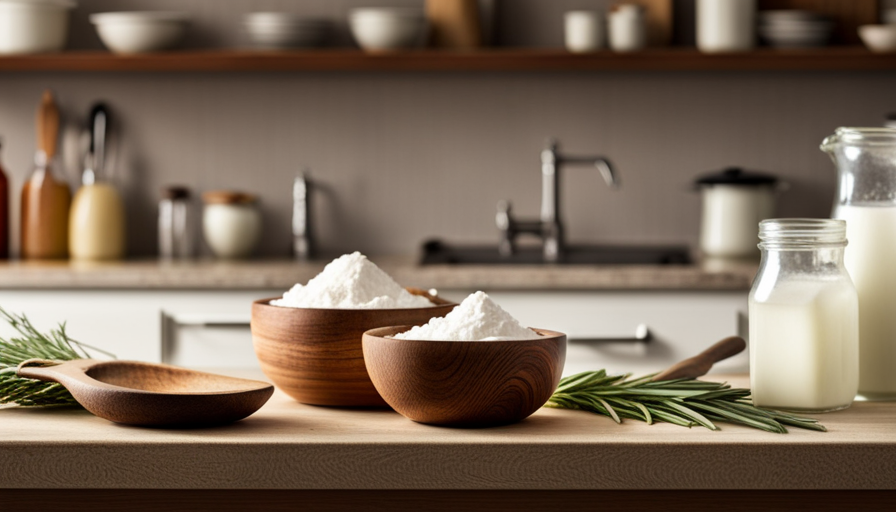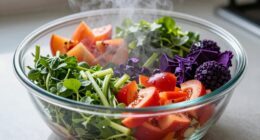Picture a thriving garden, filled with a variety of vibrant fruits and vegetables. The sun beams down, providing warmth to the soil and nourishment to the plants. You pick a crunchy apple from a tree, its sweet scent wafting through the air as you sink your teeth into it.
This is the essence of the raw food diet, a way of eating that has gained popularity in recent years. But how did this natural and unprocessed approach to nutrition become so popular?
In this article, we will explore the origins of the raw food diet and the factors that have contributed to its rise in popularity. From the influence of raw food pioneers to the impact of social media, we will delve into the various reasons why more and more people are embracing this lifestyle.
Additionally, we will examine the health benefits and claims associated with the raw food diet and its integration into mainstream culture. Join me as we uncover the fascinating journey of how the raw food diet has become a prominent force in today’s wellness landscape.
Key Takeaways
- Raw food diet gained popularity through the advocacy of Swiss physician Maximilian Bircher-Benner and raw food pioneers like Ann Wigmore.
- The raw food movement was further popularized by individuals like Victoria Boutenko and David Wolfe who promoted the consumption of raw fruits, vegetables, sprouted grains, and seeds.
- The raw food diet aligns with veganism and addresses environmental and ethical concerns associated with animal agriculture.
- The rise of the raw food diet can be attributed to the influence of online communities, social media, influencer marketing, celebrity endorsements, and the sharing of personal experiences and success stories.
The Origins of the Raw Food Diet
The raw food diet first gained popularity in the early 20th century as health enthusiasts and naturalists embraced the idea of consuming uncooked, unprocessed foods. The origins of this dietary practice can be traced back to the late 19th century, when a Swiss physician named Maximilian Bircher-Benner advocated for the consumption of raw fruits and vegetables as a means to improve health. Bircher-Benner believed that cooking destroyed vital nutrients and enzymes in food, and that a diet rich in raw plant-based foods could prevent and even cure various diseases.
Over time, the raw food diet continued to develop and gain followers. In the 1930s, Ann Wigmore, a Lithuanian-born nutritionist, popularized the idea of consuming sprouted grains and seeds as part of the raw food diet. She believed that sprouting increased the nutritional value of these foods and made them easier to digest.
The influence of raw food pioneers like Bircher-Benner and Wigmore paved the way for the modern raw food movement. Today, the raw food diet is followed by individuals seeking to improve their health, lose weight, or simply embrace a more natural way of eating.
The next section will explore the impact of these pioneers and how their ideas continue to shape the raw food movement.
The Influence of Raw Food Pioneers
One of the main reasons the raw food diet gained popularity was due to the influence of raw food pioneers. These influential figures played a crucial role in the development and promotion of the raw food movement. They dedicated their lives to advocating for the consumption of uncooked, unprocessed foods, and their efforts helped to spread awareness about the benefits of this dietary approach.
To better understand the influence of raw food pioneers, let’s take a look at a table that highlights some key figures and their contributions:
| Pioneer | Contribution | Impact |
|---|---|---|
| Ann Wigmore | Founded the Hippocrates Health Institute and popularized wheatgrass juice | Introduced the concept of using living foods for healing and rejuvenation |
| Victoria Boutenko | Authored the book "Green for Life" and promoted green smoothies | Popularized the idea of consuming blended greens for optimal nutrition |
| David Wolfe | Founded the Fruit Tree Planting Foundation and advocated for a raw, plant-based diet | Encouraged the integration of more fruits and vegetables into the diet |
These pioneers, along with many others, played a major role in bringing the raw food movement to the forefront of public consciousness. Their dedication and passion for raw, unprocessed foods inspired countless individuals to adopt this dietary approach.
In the subsequent section about health benefits and claims, we will explore the various reasons why people are drawn to the raw food diet and the potential advantages it may offer.
Health Benefits and Claims
When it comes to the health benefits of a raw food diet, there are several key points to consider.
First, many people turn to this diet as a way to lose weight, as it typically involves consuming fewer calories and more nutrient-dense foods.
Additionally, raw foods are easier to digest and can lead to improved digestion and nutrient absorption.
Finally, one of the biggest advantages of a raw food diet is the increased energy and vitality that many people experience.
Raw food diet and weight loss
Looking to shed some extra pounds? Have you ever considered trying the raw food diet? Many people turn to this diet as a way to lose weight. The raw food diet consists of consuming uncooked, unprocessed, and mostly plant-based foods. By focusing on fresh fruits, vegetables, nuts, and seeds, individuals can naturally reduce their calorie intake and promote weight loss.
Additionally, raw foods are rich in fiber, which helps to keep you feeling fuller for longer and prevent overeating. Furthermore, the diet is low in unhealthy fats and high in essential nutrients, which can support muscle gain and improve skin health. By incorporating more raw foods into your diet, you can not only lose weight but also improve your overall well-being.
Transitioning to the next section, let’s explore how the raw food diet can improve digestion and nutrient absorption.
Improved digestion and nutrient absorption
Have you ever considered how the raw food lifestyle can revolutionize your digestion and enhance nutrient absorption? The raw food diet is known for its potential to improve gut health and increase nutrient absorption.
When we eat raw foods, we consume natural enzymes that aid in the breakdown of food and enhance digestion. These enzymes help our bodies absorb essential nutrients more efficiently, leading to improved overall health.
Additionally, raw foods are rich in fiber, which promotes healthy bowel movements and prevents constipation. This, in turn, supports a healthy digestive system and contributes to improved gut health.
By following a raw food diet, we can optimize our digestion and ensure that our bodies are absorbing the maximum amount of nutrients from our food. This sets the stage for increased energy and vitality in the subsequent section.
Increased energy and vitality
Improved digestion and nutrient absorption are just the beginning of the benefits of a raw food diet. As I transitioned into this lifestyle, I noticed a significant increase in my energy levels and overall vitality. The abundance of enzymes and nutrients in raw foods provides a natural source of energy that keeps me feeling alert and focused throughout the day.
Additionally, consuming raw foods has been shown to enhance mental clarity, allowing me to think more clearly and be more productive. Not only that, but the raw food diet also provides a boost to the immune system, strengthening my body’s ability to fight off illness and disease.
With increased energy, mental clarity, and a strengthened immune system, it’s no wonder that the raw food diet has gained popularity.
Now, let’s delve into the rise of veganism and plant-based diets.
The Rise of Veganism and Plant-Based Diets
I find it fascinating to explore the connection between the raw food diet and the rise of veganism. Both diets emphasize the consumption of unprocessed, plant-based foods, and they share a common goal of promoting health and well-being.
Additionally, the environmental and ethical concerns surrounding the meat industry have been major driving forces behind the increasing interest in plant-based diets. Many individuals are now choosing to adopt these diets as a way to reduce their environmental footprint and to align their food choices with their values.
Connection between raw food diet and veganism
If you’re a vegan looking to take your plant-based diet to the next level, embracing the raw food diet can amplify your commitment to cruelty-free and sustainable living. The raw food diet goes beyond vegetarianism by emphasizing the consumption of uncooked, unprocessed foods, such as fruits, vegetables, nuts, and seeds.
This diet not only aligns with the principles of veganism but also addresses animal rights concerns. By opting for raw foods, you’re avoiding the use of animal products and supporting a lifestyle that minimizes harm to animals.
Furthermore, the raw food diet can also have positive environmental and ethical impacts. Transitioning to a raw food diet allows you to reduce your carbon footprint by decreasing energy consumption associated with cooking and food processing.
This connection between the raw food diet and veganism provides a compelling reason for vegans to explore this dietary approach.
Environmental and ethical concerns driving interest in plant-based diets
The connection between the raw food diet and veganism is quite strong. Many people who follow a raw food diet also choose to avoid animal products altogether, aligning their dietary choices with their ethical concerns about animal welfare.
In addition to personal health reasons, the environmental impact of our food choices has become a driving force behind the interest in plant-based diets. Livestock agriculture is a major contributor to greenhouse gas emissions, deforestation, and water pollution. By choosing to eat more plants and less animal products, individuals can make a positive impact on the environment.
Furthermore, the ethical concerns surrounding factory farming and the mistreatment of animals in the food industry have led many people to reevaluate their dietary choices and opt for plant-based alternatives.
As we explore the reasons why the raw food diet became popular, it’s important to consider the broader context of environmental and ethical concerns that are driving interest in plant-based diets.
Now let’s delve into how the internet and social media have played a significant role in the rise of the raw food diet.
The Internet and Social Media
With the rise of the internet and social media, the raw food diet quickly gained popularity and became a trendy lifestyle choice. Online communities and influencer marketing played a significant role in spreading awareness about the benefits of a raw food diet. Platforms like Instagram and YouTube allowed individuals to share their personal experiences and showcase their raw food creations, attracting a large following of like-minded individuals.
These online communities provided a sense of belonging and support, making it easier for people to adopt and maintain a raw food lifestyle. Influencers, who were passionate about raw food and health, used their platforms to educate and inspire others. Their visually appealing food photos and videos encouraged people to try out the diet for themselves. Many influencers also shared their personal stories of improved health and well-being, adding credibility to the raw food movement.
Moreover, the raw food diet benefited from influencer marketing strategies. Companies began partnering with influencers to promote raw food products and recipes, further increasing the diet’s visibility and appeal. This collaboration between influencers and brands helped bring the raw food diet into mainstream consciousness.
As we transition into the subsequent section about celebrity endorsements and influencer culture, it is important to note that these online communities and influencer marketing campaigns laid the foundation for the raw food diet to gain even more traction.
Celebrity Endorsements and Influencer Culture
Surprisingly, even celebrities and influencers who once indulged in indulgent meals couldn’t resist embracing the allure of raw food and its health benefits. In today’s age of celebrity influence and the impact of social media, it’s no wonder that the raw food diet has gained popularity among the rich and famous. Celebrities like Gwyneth Paltrow, Demi Moore, and Woody Harrelson have all publicly endorsed the raw food lifestyle, sharing their personal experiences and the positive effects it has had on their health and well-being.
But it’s not just the endorsement of A-list celebrities that has propelled the raw food diet into the mainstream. The rise of influencer culture on social media platforms like Instagram and YouTube has also played a significant role. Everyday people who have successfully adopted the raw food diet and documented their journey online have amassed large followings and inspired others to give it a try. Their relatable stories and before-and-after photos provide a level of authenticity and relatability that resonates with many.
To further illustrate the impact of celebrity endorsements and influencer culture, consider the following table:
| Celebrity | Social Media Platform | Raw Food Endorsement |
|---|---|---|
| Gwyneth Paltrow | Yes | |
| Demi Moore | Yes | |
| Woody Harrelson | YouTube | Yes |
As we delve into the next section about books and documentary films, it becomes evident that the raw food movement has permeated various forms of media, further fueling its popularity.
Books and Documentary Films
Books and documentary films have played a significant role in showcasing the benefits and impact of adopting a raw food lifestyle, captivating audiences with compelling narratives and visually stunning imagery. These mediums have been instrumental in popularizing the raw food diet and integrating it into popular culture.
Through books like ‘The Raw Food Revolution’ by Cherie Soria and Brenda Davis, readers have gained valuable insights into the health benefits of consuming unprocessed, plant-based foods. These books provide evidence-based information, presenting research and personal stories that highlight the positive effects of a raw food diet.
Documentary films, such as ‘Simply Raw: Reversing Diabetes in 30 Days,’ have further increased the visibility of the raw food movement. By documenting the experiences of individuals who have successfully improved their health through raw food consumption, these films have inspired many to explore this dietary approach. The visually stunning imagery and personal stories depicted in these documentaries have resonated with viewers, leading to a growing curiosity and interest in the raw food lifestyle.
As books and documentaries continue to educate and inspire individuals, they contribute to the increased awareness of food quality and processing. By highlighting the benefits of consuming raw, unprocessed foods, these mediums have encouraged people to question the traditional methods of food preparation and seek alternatives that promote better health and well-being.
Increased Awareness of Food Quality and Processing
You won’t believe how the world has been awakened to the shocking truth about the quality and processing of their food! As people become more conscious of the impact of their dietary choices on their overall health, the raw food movement has gained popularity.
Here are some key reasons behind this increased awareness:
-
Food Safety: One of the main concerns driving the popularity of the raw food diet is the growing awareness of food safety issues. With frequent recalls and outbreaks of foodborne illnesses, people are seeking alternatives that minimize the risk of contamination.
-
Increased Transparency: The raw food movement has highlighted the lack of transparency in food processing and packaging. Consumers are demanding to know what goes into their food and how it is handled, leading to a greater interest in raw and minimally processed options.
-
Nutrient Retention: Raw food enthusiasts argue that cooking can destroy vital nutrients in food. This belief has sparked a desire for raw and unprocessed foods, as individuals strive to maximize their nutrient intake.
As more individuals uncover the truth about the quality and processing of their food, personal health experiences have played a significant role in driving the popularity of the raw food diet.
The Role of Personal Health Experiences
Imagine waking up one morning feeling tired, bloated, and sluggish, and realizing that your diet may be to blame for your declining health. This was exactly my experience that led me to explore the raw food diet. I started researching the role of scientific research and discovered numerous studies highlighting the health benefits of consuming raw, unprocessed foods. These studies showed that raw foods retain more nutrients and enzymes compared to cooked foods, which can promote better digestion and overall well-being.
Furthermore, I found that cultural and societal influences played a significant role in the popularity of the raw food diet. As people became more aware of the negative effects of processed foods, they began seeking alternatives that aligned with their desire for natural and wholesome nutrition. The rise of social media platforms and health-focused influencers also contributed to the spread of information about the raw food diet, making it more accessible and appealing to a wider audience.
To evoke an emotional response in the audience, here is a table showcasing the potential benefits of the raw food diet:
| Benefit | Description | Emotional Response |
|---|---|---|
| Increased Energy | Raw foods provide natural energy without the need for stimulants. | Feel revitalized and ready to take on the day. |
| Improved Digestion | Enzymes in raw foods aid in digestion, reducing bloating. | Feel lighter and more comfortable in your own body. |
| Enhanced Immunity | Raw foods are packed with vitamins and antioxidants. | Feel empowered and protected against illnesses. |
| Clearer Skin | Nutrient-rich raw foods promote healthy skin from within. | Feel confident and radiant in your own skin. |
My personal health experiences, combined with the role of scientific research and cultural influences, led me to embrace the raw food diet. This growing popularity ultimately paved the way for mainstream acceptance and integration of this alternative approach to nutrition.
Mainstream Acceptance and Integration
After hearing about the personal health experiences of individuals who had adopted the raw food diet, I became intrigued by its potential benefits. However, I wondered how this once niche diet had gained popularity and mainstream acceptance.
As I delved deeper into my research, it became evident that cultural influences played a significant role in the increased adoption of the raw food diet.
Over the years, there has been a growing cultural shift towards prioritizing health and wellness. People are becoming more conscious of the impact their diet has on their overall well-being. This shift has led to an increased interest in alternative diets, such as the raw food diet. Celebrities, influencers, and health experts have also played a crucial role in promoting this way of eating, further fueling its mainstream acceptance.
Additionally, the rise of social media has allowed for the sharing of personal experiences and success stories with the raw food diet. People are more willing to try new things when they see others achieving positive results. As a result, the raw food diet has gained traction and become more widely accepted as a viable dietary option.
The raw food diet’s popularity can be attributed to a combination of personal health experiences, cultural influences, and mainstream adoption. As more people continue to explore alternative diets and prioritize their health, it’s likely that the raw food diet will remain a prominent dietary choice for many individuals.
Frequently Asked Questions
How does the raw food diet affect nutrient absorption in the body?
The raw food diet can have a significant impact on nutrient absorption in the body. Research shows that cooking food can reduce its nutrient content by up to 50%. By consuming raw foods, the digestive system efficiency is maximized, allowing for better absorption of essential nutrients.
Raw foods are rich in enzymes that aid in digestion, ensuring that the body can extract as many nutrients as possible from the food we eat.
Are there any potential risks or drawbacks associated with following a raw food diet?
There are potential dangers and long-term effects associated with following a raw food diet. One of the risks is nutrient deficiencies, as certain nutrients are better absorbed when cooked. For example, cooking increases the bioavailability of lycopene in tomatoes.
Additionally, consuming raw foods may increase the risk of foodborne illnesses, such as salmonella or E. coli infections. It’s important to carefully plan a raw food diet to ensure adequate nutrient intake and minimize these risks.
Can the raw food diet be customized to accommodate specific dietary restrictions or allergies?
Yes, the raw food diet can be customized to accommodate specific dietary restrictions or allergies. By focusing on raw fruits, vegetables, nuts, and seeds, individuals can easily avoid common allergens like dairy, gluten, and soy. For those with dietary restrictions, modifications can be made to include cooked foods in moderation. It’s important to consult with a healthcare professional or registered dietitian to ensure all nutritional needs are met while customizing the raw food diet to fit individual requirements.
How does the raw food diet compare to other popular diets in terms of weight loss and overall health benefits?
When comparing the raw food diet to other popular diets like the keto diet and the Mediterranean diet, there are some key differences to consider.
The raw food diet emphasizes consuming uncooked, plant-based foods, while the keto diet focuses on high fat and low carbohydrate intake.
The Mediterranean diet, on the other hand, emphasizes whole foods, including fruits, vegetables, whole grains, and lean proteins.
While the raw food diet may aid in weight loss due to its high fiber content, it may be more challenging to meet all nutritional needs.
It’s important to consult with a healthcare professional before starting any diet plan.
Is there any scientific evidence to support the claims made about the health benefits of the raw food diet?
Scientific research has explored the health claims of the raw food diet. Several studies suggest potential benefits such as weight loss, improved digestion, and increased nutrient intake. However, it is important to note that the evidence is limited and mostly based on observational studies.
Critics argue that the diet may lead to nutrient deficiencies and potential foodborne illnesses. Therefore, while there is some scientific support for the health benefits of the raw food diet, more research is needed to fully understand its long-term effects.
How Did the Raw Food Diet Influence the Evolution of Cooking Techniques?
The raw food diet has significantly impacted the ways of cooking food throughout history. As people began to incorporate more raw ingredients into their diets, they developed new techniques for preparing and preserving foods. This led to the evolution of cooking methods such as fermentation, dehydration, and pickling.
Conclusion
In conclusion, the raw food diet has become increasingly popular due to a variety of factors. One interesting statistic to note is that, according to a survey conducted by the Vegetarian Resource Group, about 3% of the U.S. population follows a vegetarian or vegan diet, with many incorporating raw food principles into their lifestyle.
This highlights the growing trend towards plant-based diets and the increasing awareness of the health benefits associated with consuming raw, unprocessed foods. As more people continue to embrace this way of eating, it’s likely that the raw food diet will continue to gain mainstream acceptance and integration into our daily lives.










